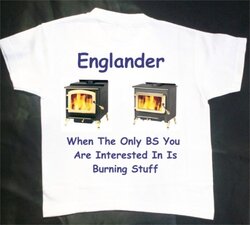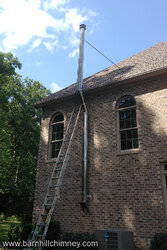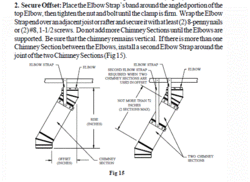I've bought an Englander 30NC (Home Depot) and am preparing to (self) install it.
I plan to build the hearth of steel 2x4 material, framed to a height of ~ 12", maybe a little higher. Skinned with 2 layers of durock and then floor tile on thinset.
The wall protection will be about the same, stood off the wall 2" and I plan to use that expanded metal mesh/lathe to seal the airspace from either critters or the random flotsam and jetsam such as you find under the sofa after a year or two. I plan on a 2" "grille" at the wall base (where it meets the hearth) and then the top edge.
The chimney... unsure from the stove to the wall thimble, but then double wall class A through the wall into a class A chimney stack. That goes up the exterior to the ridge line. The chimney happens to fall almost at the ridge, once it gets up there. That will be at *least* a 25' rise from the bottom of the chimney to the top. Possibly closer to 30' The house is 2 1/2 stories (third floor has those old tyme slanted walls - this the gable end).
Some questions...
Reading the manual and internet resources, I gather a 6" chimney system will be adequate. *Must* I go to 8"? *Should* I?
When I reach the roof line, can I kick out a foot or two with 45* elbows or do I need to cut through the gable overhang?
Any particular manufacturer I should prefer or avoid?
I'm highly motivated to get this right - I can't seem to find much material on this exact chimney solution. I'm particularly interested in exactly how the chimney base attaches to outside wall. Do I strip the siding first, for instance? I'm quite sure I need to hit the studs, but with what? 3" ??? screws? Lag bolts?
Any other pitfalls?
(yes, this will be permitted, btw)
If there is a thread that covers these points, please link. I've been reading endlessly on this and still have these (and a few other) questions.
I plan to build the hearth of steel 2x4 material, framed to a height of ~ 12", maybe a little higher. Skinned with 2 layers of durock and then floor tile on thinset.
The wall protection will be about the same, stood off the wall 2" and I plan to use that expanded metal mesh/lathe to seal the airspace from either critters or the random flotsam and jetsam such as you find under the sofa after a year or two. I plan on a 2" "grille" at the wall base (where it meets the hearth) and then the top edge.
The chimney... unsure from the stove to the wall thimble, but then double wall class A through the wall into a class A chimney stack. That goes up the exterior to the ridge line. The chimney happens to fall almost at the ridge, once it gets up there. That will be at *least* a 25' rise from the bottom of the chimney to the top. Possibly closer to 30' The house is 2 1/2 stories (third floor has those old tyme slanted walls - this the gable end).
Some questions...
Reading the manual and internet resources, I gather a 6" chimney system will be adequate. *Must* I go to 8"? *Should* I?
When I reach the roof line, can I kick out a foot or two with 45* elbows or do I need to cut through the gable overhang?
Any particular manufacturer I should prefer or avoid?
I'm highly motivated to get this right - I can't seem to find much material on this exact chimney solution. I'm particularly interested in exactly how the chimney base attaches to outside wall. Do I strip the siding first, for instance? I'm quite sure I need to hit the studs, but with what? 3" ??? screws? Lag bolts?
Any other pitfalls?
(yes, this will be permitted, btw)
If there is a thread that covers these points, please link. I've been reading endlessly on this and still have these (and a few other) questions.




